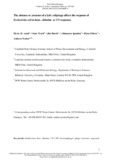JavaScript is disabled for your browser. Some features of this site may not work without it.
| dc.contributor.author | Ameh, Ekwu M. | |
| dc.contributor.author | Tyrrel, Sean | |
| dc.contributor.author | Harris, Jim A. | |
| dc.contributor.author | Ignatiou, Athanasios | |
| dc.contributor.author | Orlova, Elena | |
| dc.contributor.author | Nocker, Andreas | |
| dc.date.accessioned | 2018-05-09T10:42:54Z | |
| dc.date.available | 2018-05-09T10:42:54Z | |
| dc.date.issued | 2018-03-15 | |
| dc.identifier.citation | Ameh EM, Tyrrel S, Harris J, Ignatiou A, Orlova E, Nocker A, The absence or presence of a lytic coliphage affects the response of Escherichia coli to heat, chlorine, or UV exposure, Folia Microbiologica, Volume 63, Issue 5, 2018, pp. 599-606 | en_UK |
| dc.identifier.issn | 0015-5632 | |
| dc.identifier.uri | http://dx.doi.org/10.1007/s12223-018-0600-9 | |
| dc.identifier.uri | http://dspace.lib.cranfield.ac.uk/handle/1826/13194 | |
| dc.description.abstract | Disinfection aims at maximal inactivation of target organisms and the sustainable suppression of their regrowth. Whereas many disinfection efforts achieve efficient inactivation when the effect is measured directly after treatment, there are questions about the sustainability of this effect. One aspect is that the treated bacteria might recover and regain the ability to grow. In an environmental context, another question is how amenable surviving bacteria are to predation by omnipresent bacteriophages. Provisional data suggested that bacteria when subjected to sublethal heat stress might develop a phage-resistant phenotype. The result made us wonder about the susceptibility to phage-mediated lysis for bacteria exposed to a gradient of chlorine and UV-LED disinfection strengths. Whereas bacteria exposed to low sublethal chlorine doses still underwent phage-mediated lysis, the critical chlorine Ct of 0.5 mg min/L eliminated this susceptibility and induced phage resistance in the cells that survived treatment. In the case of UV, even the smallest tested dose of 2.8 mJ/cm2 abolished phage lysis leading to direct regrowth. Results suggest that bacteria surviving disinfection might have higher environmental survival chances directly after treatment compared to non-treated cells. A reason could possibly lie in their compromised metabolism that is essential for phage replication. | en_UK |
| dc.language.iso | en | en_UK |
| dc.publisher | Springer | en_UK |
| dc.rights | Attribution-NonCommercial 4.0 International | * |
| dc.rights.uri | http://creativecommons.org/licenses/by-nc/4.0/ | * |
| dc.subject | Disinfection | en_UK |
| dc.subject | Heat | en_UK |
| dc.subject | Chlorine | en_UK |
| dc.subject | UV-LED | en_UK |
| dc.subject | Bacteriophages | en_UK |
| dc.subject | Phage resistance | en_UK |
| dc.subject | Regrowth | en_UK |
| dc.title | The absence or presence of a lytic coliphage affects the response of Escherichia coli to heat, chlorine, or UV exposure | en_UK |
| dc.type | Article | en_UK |
Files in this item
The following license files are associated with this item:
This item appears in the following Collection(s)
-
Staff publications (SWEE) [2825]

